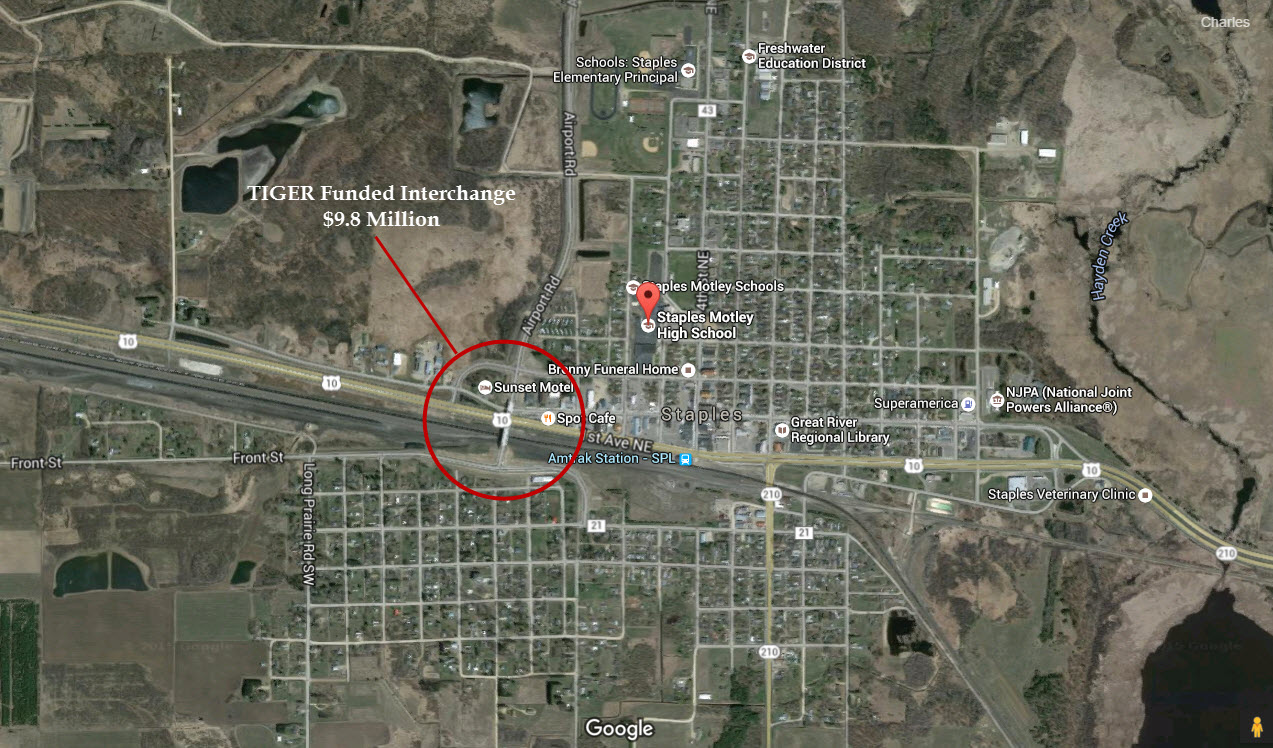The Tiger Still Sleeps in Staples
Transportation advocacy people love the Transportation Investment Generating Economic Recovery (TIGER) program. They help create Complete Streets and great neighborhoods we're told. They showcase innovation and make needed improvements for people on bikes. I especially like this graphic from People for Bikes (a group of good people) who suggest a process that starts with identifying a need and ends in celebration and enjoyment. What's not to like?
Back in 2010, I wrote about the TIGER project in one of the nearby communities. My questioning of the manna from Washington marked the schism between myself and the local insider crowd in the same way Martin Luther's theses nailed to the church door marked his. I'm yet to be as successful as Luther, yet, much like the father of the Reformation, history seems to be on my side.
The Staples Interchange, a $9.8 million dollar overpass in a community 2,900 people, was going to create jobs and economic development. It was going to improve safety and lead to greater prosperity. This innovation (seriously?) in transportation funding was the only construction project in Minnesota that year and it was hailed -- by local and national advocates -- as a great improvement. Here's what Transportation for America said at the time:
The people in Staples, Minnesota stuck in traffic downtown for hours each day while an average of 52 long trains pass through town could probably vouch for the benefits and reduced congestion that will come from a brand new bridge and crossing.
The absurdity of all of this -- the absolute unreal nature of this entire conversation -- prompted me to write a five part series on cost benefit analyses that, if you're not already outraged, will make you sickened at the math we use to justify federal transportation spending. We use fancy formulas to lie to ourselves, and we bankrupt our cities in the process.
So, here's Staples, Minnesota, with their new interchange.
Those of you that actually experience a modicum of congestion on a regular basis will note -- as I did six years ago -- how absurd is the suggestion that there is anything resembling congestion in Staples. Here's a random street shot from Google - explore it yourself.
Let's zoom in and check out all that new growth and jobs that have come about in the last six years as a result of this investment.
Someone point to a new job -- just one single job -- that now exists, and otherwise would not have, thanks to this $10 million investment.
One of the main reasons -- according to the cost benefit analysis -- for building the interchange was to improve safety, particularly for emergency response vehicles. The argument was that, with train delays, it was taking too long for ambulances to reach the hospital and this was a threat to public health. For some context, here is the location of the recently built hospital:
And for the train lovers out there that are going to argue that this is an Amtrak line -- as you did back in 2010 -- check your schedule. The Empire Builder comes through twice a day. If it is on time -- it occasionally is -- it passes through in the early, early AM.
If you sit in a cubical in Washington DC, TIGER may feel like an innovative program because it allows you to skip over all the messed up bureaucracy and politics that dominates transportation funding today. If you work in an advocacy organization outside of Washington DC, TIGER may feel like your best chance to get a big splash of money for your local initiative.
For me, the TIGER program combines the worst of Orderly but Dumb financing with all the known downsides of Chaotic but Smart approaches, a hit and miss outcome except with your savings account, not your bingo money. That this feeds the food chain of dysfunction -- from empowering more beltway lobbyists to encouraging local advocates to look to Washington instead of their own initiative -- makes it one of our worst programs.
This is not innovation. It's another way to lie to ourselves. Let's stop pretending we can do scalpel work on our neighborhoods with huge Washington budgets and bureaucracy. It just messes everything up where it doesn't paralyze real innovation.
#NoNewRoads





Charles Marohn (known as “Chuck” to friends and colleagues) is the founder and president of Strong Towns and the bestselling author of “Escaping the Housing Trap: The Strong Towns Response to the Housing Crisis.” With decades of experience as a land use planner and civil engineer, Marohn is on a mission to help cities and towns become stronger and more prosperous. He spreads the Strong Towns message through in-person presentations, the Strong Towns Podcast, and his books and articles. In recognition of his efforts and impact, Planetizen named him one of the 15 Most Influential Urbanists of all time in 2017 and 2023.